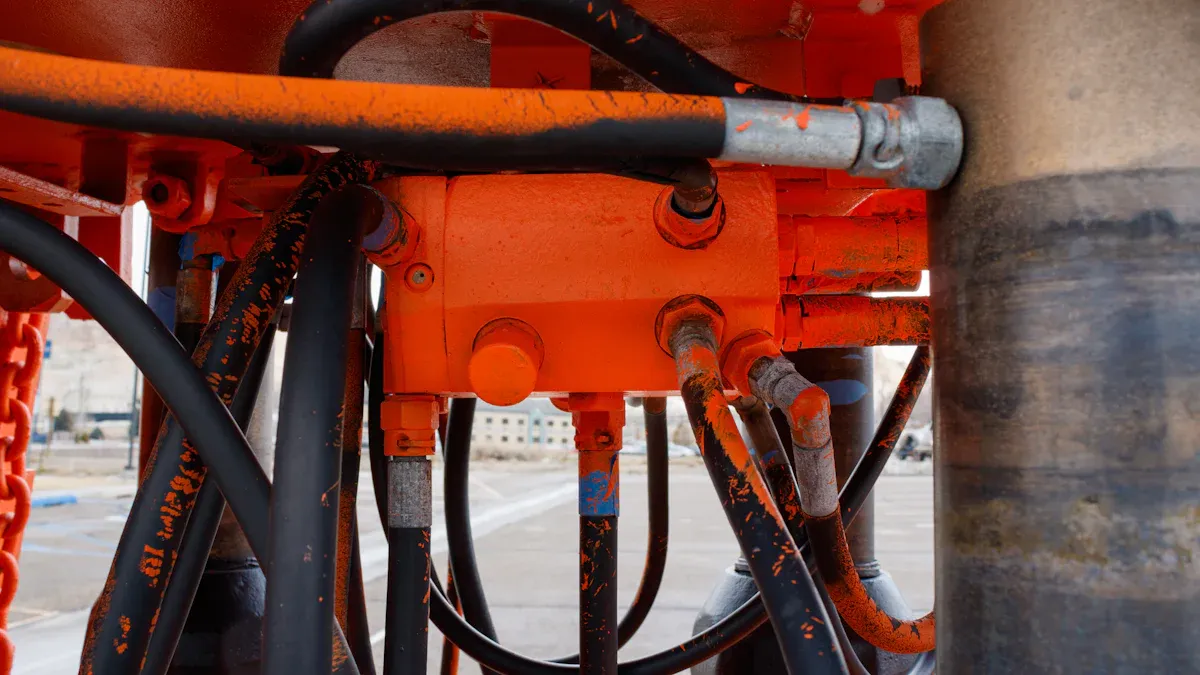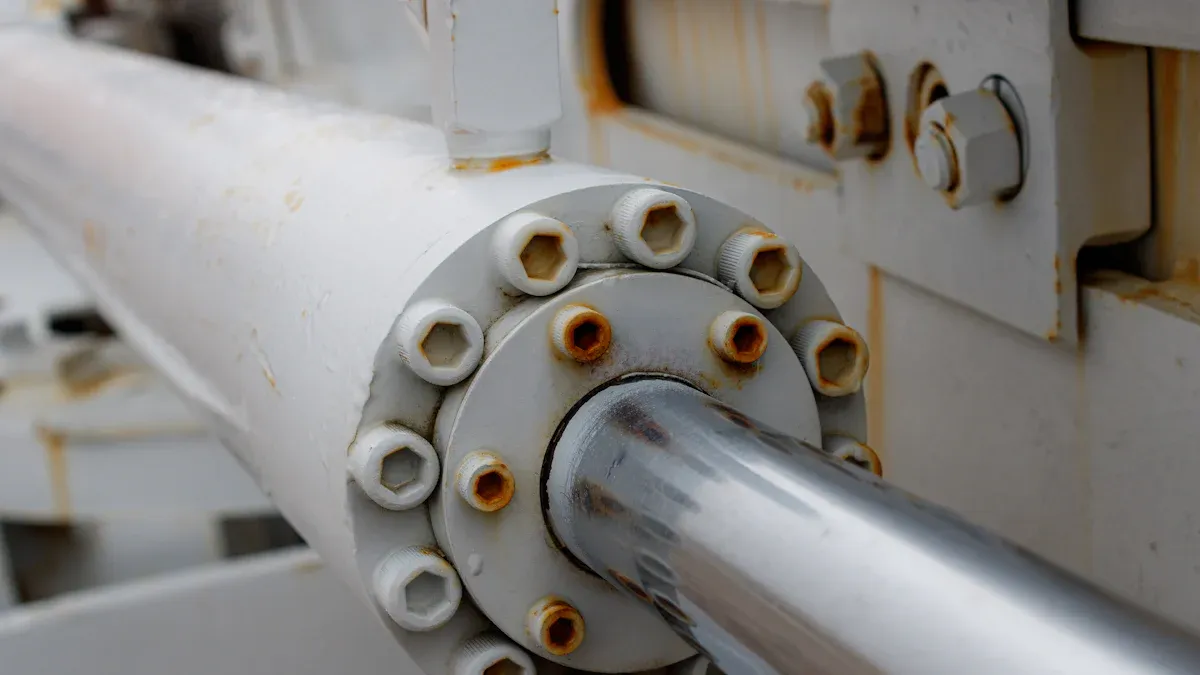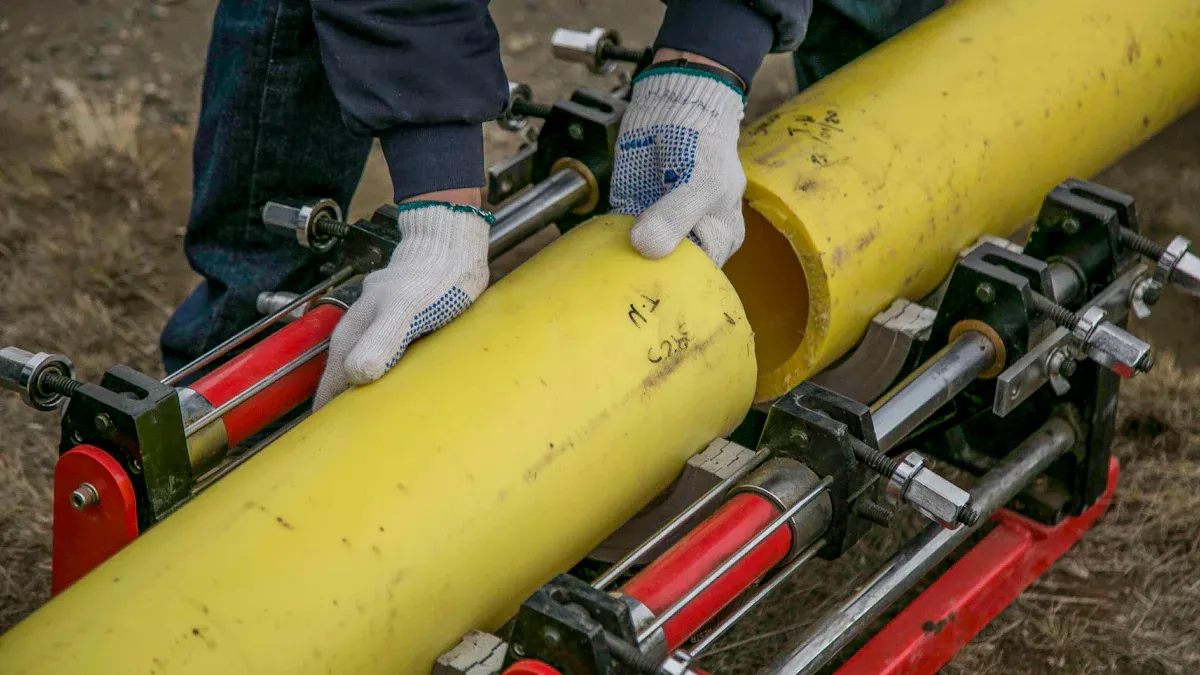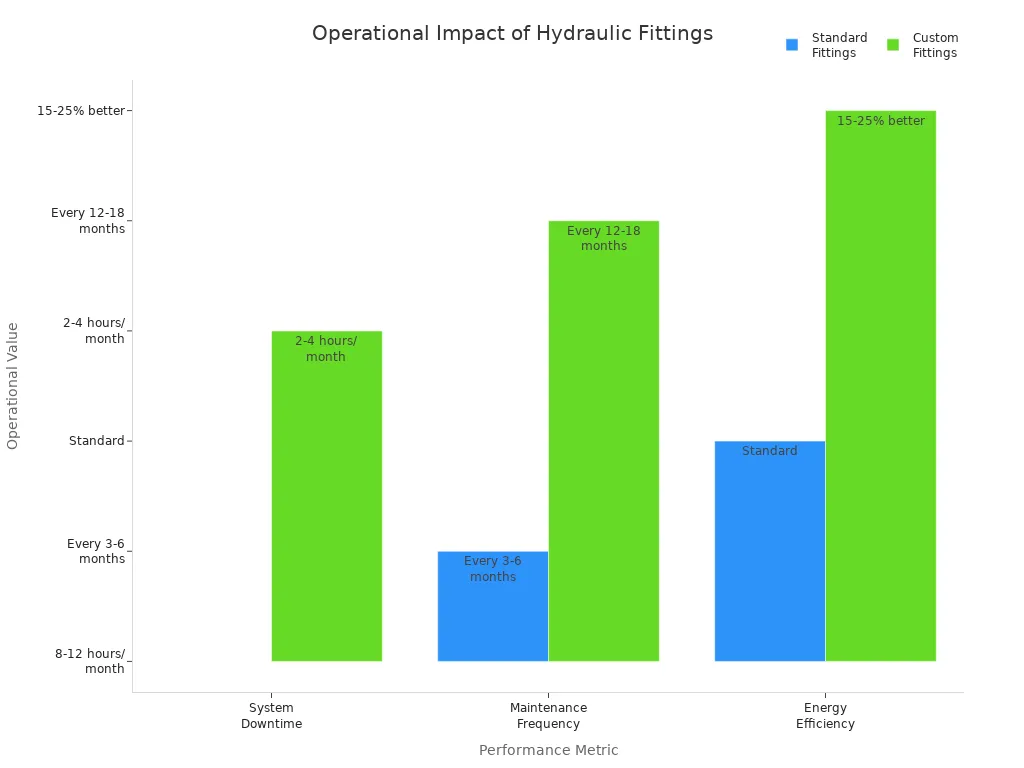
Selecting the proper hydraulic fittings is essential for keeping workers and equipment safe. Many accidents are caused by leaks or bursts from hydraulic fittings that do not meet system requirements. Industry data reveals that nearly 40% of hydraulic system failures are related to hose fittings. Stainless steel hydraulic fittings, particularly those produced by a reputable hydraulic fittings manufacturer, provide superior protection. When it comes to hydraulic fittings for construction machinery, choosing hydraulic fittings compatible with Parker can help avoid expensive downtime and reduce workplace hazards.
Key Takeaways
- Choosing the right hydraulic fittings prevents leaks and bursts, protecting workers and equipment from injuries and costly damage.
- Matching fittings to system pressure, material, and size ensures safe, reliable operation and reduces downtime.
- Proper installation, regular inspections, and using quality materials keep hydraulic systems clean, safe, and efficient.
How Hydraulic Fittings Prevent Safety Hazards

Preventing Leaks and Fluid Loss
Leaks in hydraulic systems can create dangerous situations. When hydraulic fittings do not seal properly, high-pressure fluid can escape. This fluid may cause slip hazards, burns, or even fluid injection injuries. Many safety audits report that leaks often happen because of improper assembly, over-tightening, or using the wrong type of fitting. Workers sometimes use their hands to check for leaks, but this can lead to serious injuries. Instead, they should use safe tools like cardboard or wood.
A well-chosen hydraulic fitting helps prevent leaks by matching the system’s pressure and vibration needs. For example, O-ring face seal (ORFS) fittings work well in high-pressure and high-vibration settings. The design of the seal groove and the surface finish of the fitting also matter. Even a small error in the groove size or a rough surface can cause leaks. Proper torque during installation is important, too. Both over-tightening and under-tightening can lead to leaks or damaged seals.
Here’s a quick look at what matters most for leak prevention:
| Factor | Why It Matters |
|---|---|
| Seal Groove Design | Precise grooves keep seals in place and prevent leaks at high pressure. |
| Surface Finish | Smooth surfaces help seals work better and block fluid paths. |
| Fitting Selection | The right type handles system pressure and vibration without leaking. |
| Torque Application | Correct torque keeps the seal tight but not crushed. |
| Vibration Mitigation | Reduces loosening and leak risks in moving equipment. |
| Installation Quality | Training and proper tools ensure secure, leak-free connections. |
Regular inspections and following manufacturer guidelines help keep leaks under control. Cleanliness during installation also matters. Dirt or debris can stop a fitting from sealing, leading to fluid loss.
Avoiding System Bursts and Pressure Failures
System bursts are among the most dangerous failures in hydraulic equipment. When a fitting cannot handle the system’s pressure, it may blow off or rupture. This sudden release of high-pressure fluid can cause burns, lacerations, or even death. It also leads to equipment damage, costly downtime, and environmental spills.
Common causes of bursts include using incompatible fittings, improper assembly, or not tightening to the correct torque. Sometimes, workers use the wrong tools or skip steps during installation. Incomplete hose insertion or mismatched threads can also cause fittings to fail under pressure.
- Safety hazards from bursts:
- High-pressure fluid release can cause severe injuries.
- Equipment may shut down, leading to lost productivity.
- Hydraulic fluid spills can contaminate soil and water.
- Repairs and cleanup add to costs.
Case studies show that pressure failures often happen when fittings are not rated for the system’s pressure or are installed incorrectly. Regular checks, proper training, and using the right hydraulic fittings for the job help prevent these dangerous events.
Reducing Contamination and Environmental Risks
Hydraulic fittings do more than just hold fluid in—they also keep contaminants out. Dirt, dust, and water can enter the system if fittings are not sealed or installed correctly. Contaminants can damage pumps, valves, and other parts, leading to more leaks and failures.
Properly installed hydraulic fittings use seals like O-rings to block entry points for dirt and moisture. Workers should keep hoses and fittings clean before connecting them. Using plugs and caps during storage helps prevent airborne contamination. Regular inspections catch worn or damaged fittings before they cause bigger problems.
Tip: Training workers on safe connection and disconnection practices reduces the risk of spills and contamination.
Environmental safety is a big concern in large operations. Leaks and spills from failed fittings can pollute soil and water, leading to fines and cleanup costs. Good fitting practices protect both the equipment and the environment. They also help companies avoid legal trouble and extra insurance claims.
Key Factors in Selecting Safe Hydraulic Fittings

Compatibility with Hoses, Tubes, and System Components
Choosing the right hydraulic fittings starts with making sure they fit well with hoses, tubes, and other system parts. When parts do not match, leaks and failures can happen. Manufacturers recommend checking several things before picking a fitting:
- Size: The inner and outer diameters must match to avoid pressure loss and damage.
- Temperature: Both the hose and fitting should handle the fluid and outside temperatures.
- Application: Use fittings designed for the specific job, and stick with original equipment when possible.
- Material/Media: Pick materials that work with the fluid and the environment, like saltwater or chemicals.
- Pressure: Make sure all parts can handle the system’s working pressure, including any spikes.
- Ends: Choose the right ends and attachment methods for the equipment.
- Delivery: Keep everything clean and tested before installation to prevent contamination.
Note: Following the STAMPED process (Size, Temperature, Application, Material, Pressure, Ends, Delivery) helps reduce downtime and keeps the system running smoothly.
Problems often come from using the wrong materials or not matching threads and seals. For example, if a seal does not match the hydraulic oil, it can fail and cause leaks. Using high-quality, compatible seals and following proper installation steps helps prevent these issues. In short, matching all parts correctly keeps the system safe and reliable.
Material Selection for Pressure and Temperature Demands
The material of hydraulic fittings matters a lot for safety and long life. Stainless steel is a top choice for high-pressure and high-temperature jobs. It resists rust and stays strong in tough places like factories, oil rigs, and ships. Some jobs need even stronger alloys, like Monel or Hastelloy, especially when facing extreme conditions.
Here’s a quick look at common materials:
| Material | Advantages | Disadvantages | Best Use Case |
|---|---|---|---|
| Stainless Steel | Strong, resists corrosion, durable | More expensive, harder to machine | High-pressure, high-temperature systems |
| Carbon Steel | Strong, affordable | Can rust in harsh environments | General hydraulic systems |
| Brass | Easy to machine, resists corrosion | Wears out under high pressure | Low to medium pressure systems |
Stainless steel works well with many fluids, even those that can cause rust or chemical damage. Carbon steel is good for most jobs but does not last as long in wet or salty places. Brass is best for lighter jobs. Picking the right material means the fittings will last longer and keep the system safe.
Pressure Ratings and Safety Margins
Pressure ratings tell you how much force a hydraulic fitting can handle. If a fitting cannot take the pressure, it might burst or leak. International standards like SAE and ISO set rules for these ratings. They also require a safety margin, usually a 4:1 ratio. This means the fitting’s burst pressure is four times higher than its working pressure.
- Working pressure: The highest pressure the fitting can handle every day.
- Burst pressure: The point where the fitting fails completely.
Testing makes sure fittings meet these numbers. Tests include:
- Hydrostatic proof testing (1.5 to 2 times working pressure)
- Burst testing
- Impulse testing (for pressure changes)
- Environmental testing (for temperature and corrosion)
Tip: Always pick fittings that meet or beat the system’s pressure needs. Regular checks and using the right tools during assembly help prevent failures.
If someone uses a fitting with the wrong pressure rating, it can lead to leaks, bursts, and even injuries. Pressure spikes and vibration make these problems worse. That’s why it’s important to follow standards and use fittings with the right safety margins.
Correct Sizing and Thread Matching
Getting the size and threads right is key for a leak-free and safe system. Even a small mistake can cause big problems. Experts suggest using calipers or micrometers to measure hose and pipe diameters. Take several measurements to catch any wear or odd shapes.
- Check manufacturer manuals for sizing and pressure details.
- Match thread types (like NPT, BSP, JIC) to avoid leaks.
- Make sure O-rings fit snugly and compress well.
- The tubing’s outer diameter should match the fitting for a tight seal.
- Pick materials and O-rings that work with the fluid and the environment.
- Follow standards like ISO 8434-3 and SAE J1453 for best results.
Regular maintenance and checks help spot wear or damage early. This keeps the system safe and running longer.
Correct sizing and thread matching stop leaks and make sure the hydraulic fittings work as they should. This step is simple but very important for system safety.
Selecting the right hydraulic fittings keeps people, equipment, and the environment safe.
- Material compatibility, pressure ratings, and accurate sizing all help prevent leaks and bursts.
- Custom fittings and proper assembly reduce downtime and extend system life.

Choosing safe fittings means fewer repairs, better performance, and peace of mind.
FAQ
What happens if someone uses the wrong hydraulic fitting?
Using the wrong fitting can cause leaks, bursts, or system failure. This puts people and equipment at risk. Always check compatibility before installation.
How often should workers inspect hydraulic fittings?
Workers should inspect fittings during regular maintenance or after any system change. Early checks help spot wear, leaks, or damage before bigger problems start.
Can a worker reuse old hydraulic fittings?
Most experts say not to reuse old fittings. Old parts may have hidden damage or wear. New fittings give better safety and performance.
Post time: Aug-13-2025
